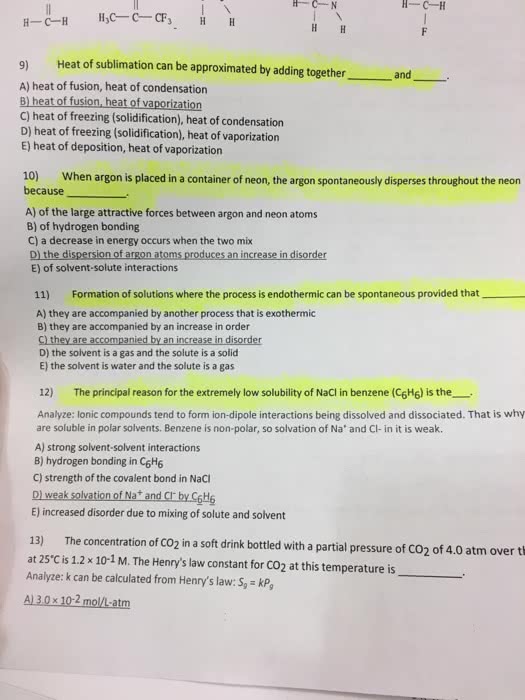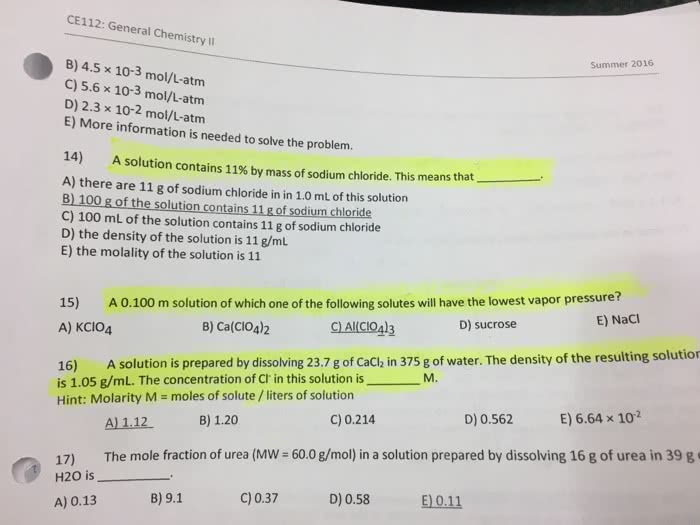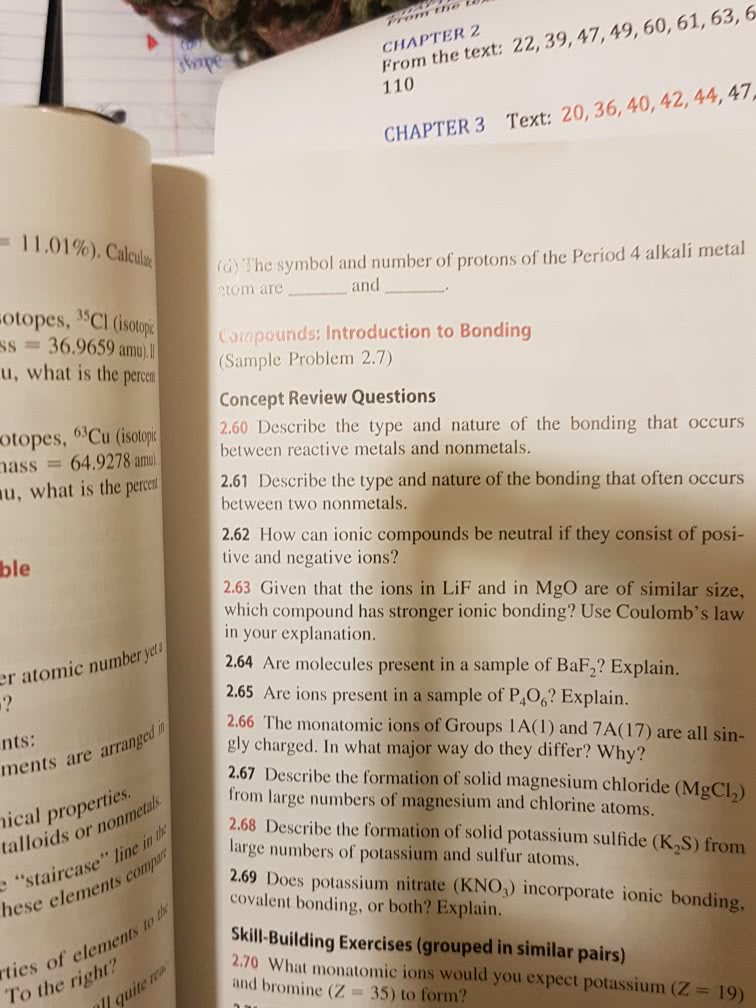CHEM 111 Chapter Notes - Chapter 5: Covalent Bond, Ionic Compound, Metallic Bonding

Chapter 5: Ionic and Covalent Compounds
● Formation and Electron Configuration of Ions
○ Coulomb’s Law
■ Matter is made up of atoms and ions that experience both attractive and
repulsive forces. The strength of the force between two charged particles
together in any material is described by Coulomb’s law. According to this law, the
force of attraction or repulsion between two charged species is directly
proportional to the magnitude of the charge on the particles and inversely
proportional to the square of the distance between the two particles
■
■ Both attractive and repulsive forces exist in matter, and it is the balance of these
forces (and the resulting overall decrease in energy) that results in the formation
of chemical bonds, interactions that hold two or more atoms together.
■ Chemical attractive forces involve opposite charges, such as those between
protons in a nucleus and the electrons surrounding that nucleus, and between
positive and negative ions. Repulsive forces occur between species with like
charges, such as the positively charged nuclei of two bonded atoms.
■ Chemical bonding can be categorized by the types of attractive forces that exist
between particles.
■ metallic bonding is attractive forces that exist between the electrons and nuclei in
metal atoms. Attractive forces are responsible for more than chemical bonding.
There are forces that exist between molecules, called intermolecular forces
○ Cations
■ A cation forms when an atom loses one or more electrons. Metals have low
ionization energy values, so metals generally form cations.
■ The energy required to remove a second electron from an atom is the second
ionization energy, IE2. For any atom, IE2 > IE1.
■ In general, when metals form cations, they lose electrons from the
highest-energy occupied orbitals, those with the highest n value.
■ Transition metals have valence electrons in ns, (n-1)d, and in the case of
lanthanides and actinides, (n-2)f orbitals. When a transition metal forms a cation,
electrons are first lost from the outermost occupied orbital (the orbital with
highest n ).

■ electrons are removed from the highest-energy orbitals because those electrons
feel the weakest attractive “pull” from the positively charged nucleus.
■ Transition metals often form more than one cation.
○ Predicting Cation Charge Based on Periodic Group
■ Most metals in the main groups of the periodic table (Groups 1A to 7A) form
monatomic ions that have a charge related to the group number of the element.
■ Metals in Groups 1A, 2A, and 3A form cations that have a positive charge equal
to the group number of the element.
■ Other metals form cations with charges that are not easily predicted.
■ Transition metals typically form cations with charges ranging from +1 to +3. Many
transition metals form more than one monatomic ion.
■ Other than aluminum, the metals in Groups 3A, 4A, and 5A form cations with
positive charges that are not easily predicted.
○ Anions
■ An anion forms when an atom gains one or more electrons. Nonmetals have
relatively large, negative electron affinity values, so nonmetals generally form
anions.
■ The total number of electrons gained when an element forms an anion is related
to the electron configuration of the element.
○ Predicting Anion Charge Based on Periodic Group
■ Most nonmetals in the main groups of the periodic table (Groups 1A to 7A) form
monatomic ions that have a charge related to the group number of the element.
○ Lewis Symbols
■ A method for representing an element’s valence electrons was proposed in 1902
by Gilbert N. Lewis (1875–1946) when he drew a cube and placed a valence
electron at its corners
■ The modern Lewis symbol for an element uses the element symbol to represent
the nucleus and core (non-valence) electrons and dots to represent valence
electrons.
■ In a Lewis symbol, electrons are arranged around the four sides of the element
symbol.
■ A Lewis symbol shows the total number of valence electrons for an element.
■ Lewis symbols can be drawn to reflect the electron configuration of the element
(the number of paired and unpaired electrons in the ground-state electron
configuration of the element), but this is not an absolute rule
○ Ion Size
■ The size of an ion is related both to the size of the atom from which it is formed
and the ion charge
■ Cations are smaller than the atoms from which they are formed.
■ Anions are larger than the atoms from which they are formed.
■ Anions are generally larger than cations.
■ Cations are smaller than the atoms from which they are formed primarily
because they have fewer electrons.
■ Anions are larger than the atoms from which they are formed primarily because
of their added electrons.
● Polyatomic Ions and Ionic Compounds
○ Polyatomic Ions

■ Polyatomic ions are groups of covalently bonded atoms that carry an overall
positive or negative charge
● Representing Ionic Compounds with Formulas
○ Ionic compounds are represented by empirical formulas that show the simplest ratio of
cations and anions in the compound. In the formula of an ionic compound, the cation
symbol or formula is always written first, followed by the anion symbol or formula. Ionic
compounds do not have a positive or negative charge because the total cationic positive
charge is balanced by the total anionic negative charge. This means that it is possible to
predict the formula of an ionic compound if the cation and anion charges are known.
○ When the formula of an ionic compound contains a polyatomic ion, parentheses are used
if more than one polyatomic ion is needed to balance the positive and negative charges
in the compound.
● Naming Ionic Compounds
○ Ions and ionic compounds are named using guidelines created by the International Union
of Pure and Applied Chemistry (IUPAC). Naming ionic compounds involves identifying
the charges on the monoatomic and polyatomic ions in a chemical formula, so it is
important to memorize the rules for predicting the charges on monoatomic ions and the
names, formulas, and charges on polyatomic ions.
● Rules for Naming Ions and Ionic Compounds
○ Monatomic cations
■ The name of a main-group monoatomic cation is the element name followed by
the word ion.
■ The name of a transition metal cation is the element name followed by the cation
charge in Roman numerals within parentheses and the word ion.
○ Monatomic anions
■ The name of a monoatomic anion is the element name changed to include the
suffix -ide, followed by the word ion.
○ Polyatomic ions
Polyatomic Ions
Name
NH4
+
Ammonium ion
OH-
Hydroxide ion
CN-
Cyanide ion
CH3CO2
-
Acetate ion
SO3
2-
Sulfite ion
SO4
2-
Sulfate ion
HSO4
-
Hydrogen sulfate ion (bisulfate ion)
S2O3
2-
Thiosulfate ion
PO4
3-
Phosphate ion




